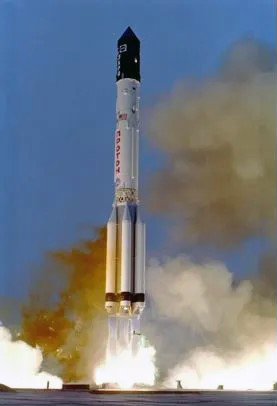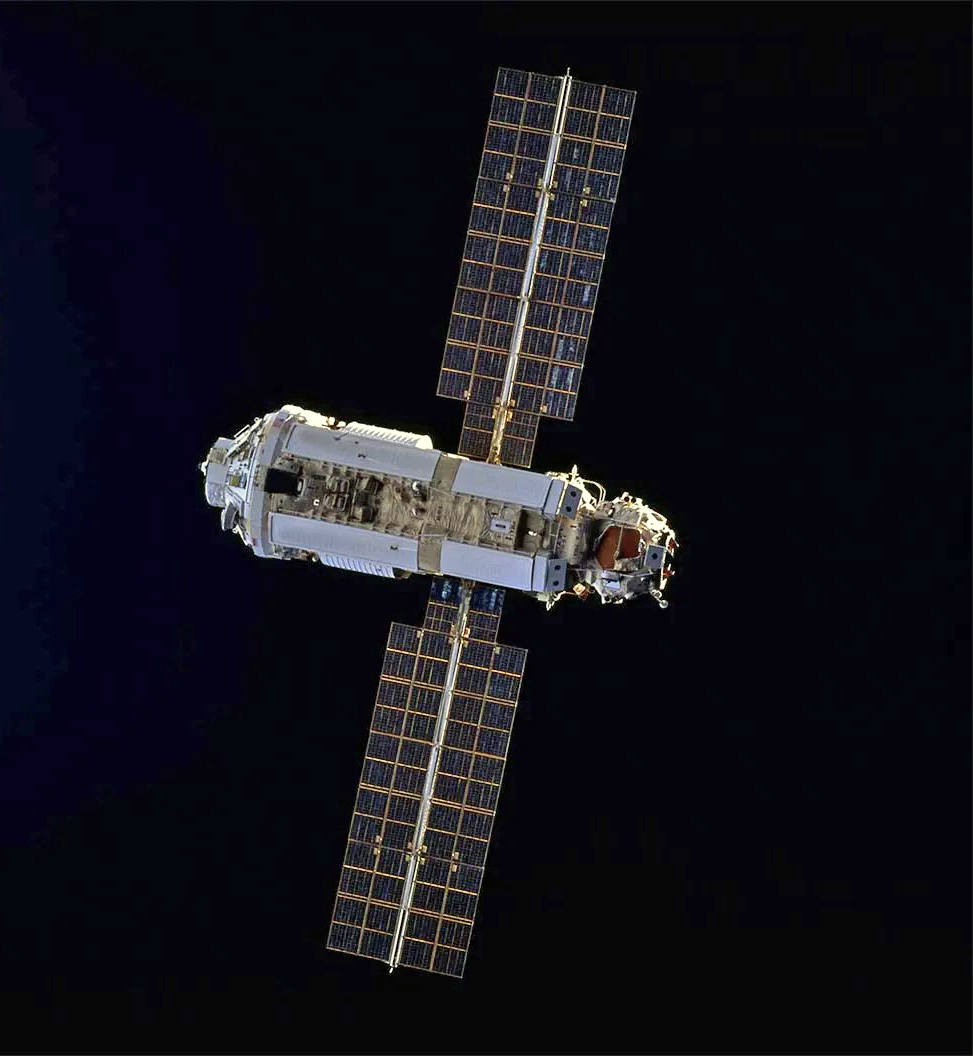


Zarya Launch Operations: 20 November 1998
At 09:40 Moscow Time (MT) on 20 November, the Proton launch vehicle carrying the first element of the International Space Station (ISS) left the launch pad at the Baikonur Cosmodrome in Kazakhstan and headed for orbit. After decades of planning and years of delay, the first step in the creation of a huge space station in Earth orbit had finally begun.
The Russian Control Module Zarya (Sunrise) had been transported to the launch pad by rail on 16 November to undergo final preparations for its launch. The rollout came after both U.S. and Russian officials had met to review the status of the vehicle and its booster. The launch was to be witnessed by top ISS programme officials from the leading space agencies of America, Russia, Canada, Europe and Japan.
Fuelling of the giant rocket began six hours before launch, at 03:40 MT, with the oxidizer being pumped into the Proton's tanks. This was followed at 05:20 by propellant fuelling. The launch gantry was retracted at 08:30.
Ten minutes later, a full check of the onboard systems of the launch vehicle and its payload was begun. At 09:30, ground systems confirmed a 'go' for launch and this was followed one minute later by the Zarya Module being switched to internal power. The final launch sequence began at 09:35. The six first-stage engines received the 'ignition sequence' command just 2.5 seconds before lift-off and this was followed at T-1.6 seconds by the 'engine start' command.
At the end of a flawless countdown, the engines lifted the Proton and Zarya off the launch pad and into overcast skies. At 2 minutes 6 seconds GET (Ground Elapsed Time), with the vehicle travelling at 5,955 kph (3,700 mph) at an altitude of 43.5 km (27 miles), the first stage was separated. This was followed 57 seconds later by the separation of the nose fairing, revealing the Zarya Module beneath. The second stage separated at GET 5 minutes 34 seconds, having lifted the vehicle to 138 km (86 miles) and 15,932.5 kph (9,900 mph). The separation of the third stage came at GET 9 minutes 47 seconds, having carried the module to 185 km (115 miles) altitude and 27,198 kph (16,900 mph). Zarya's initial orbit around the Earth was 185 x 354 km (115 x 220 miles), inclined at 51.6 degrees to the equator and with a period of 90 minutes.
The First Week: 20-27 November 1998
As Zarya separated from the third stage of the Proton, a sequence of pre-programmed events was initiated to configure the module for orbital operations. In Earth orbit, some 10 minutes and 5 seconds after leaving the launch pad, the KURS and Komparus antennas were automatically deployed, activating critical commmunications and rendezvous systems. The docking probe was then extended at GET 10 minutes 52 seconds. This would enable the Service Module (Zvezda - due at this stage to launch in the summer of 1999) to dock with Zarya (also known as the Functional Cargo Block - Russian acronym FGB). Finally, at GET 13 minutes 21 seconds, the twin solar arrays were deployed to enable the module to convert sunlight into electrical power and allow onboard systems to be switched to operating mode.
A little over three hours after launch, flight controllers at the Russian Flight Control Centre, TsUP (pronounced 'soup') in Korolyov City, Moscow (TsUP-M) successfully uplinked commands to orientate Zarya so that it would be heated evenly across its surfaces. The first few hours aloft also enabled controllers to test the ability of the solar arrays to track the sun. The successful test meant that the panels would maximise the opportunity to draw upon the sunlight on each orbit and provide power for various systems aboard Zarya. It also allowed the batteries to recharge prior to their use during the short night-pass of each orbit. The round-the-clock monitoring of the ISS had begun.
Activities carried out in the first 24 hours on orbit included firings of the onboard engines to begin to change the orbital altitude prior to a rendezvous by the Space Shuttle Endeavour, planned for 6 December on mission STS-88. These firings were 10 seconds and 40 seconds long, initiating the increase of the module's orbit to an eventual 389.5 km (242 miles). This would be the orbit at which the Shuttle would capture the FGB and attach the American Unity Node 1 module.
Russian flight controllers also tested the module's black-and-white TV system in two tests to verify its function, as the system would be used during the docking of the Zvezda module. Both Russian and American flight controllers staffed the Russian Mission Control Centre to monitor Zarya's systems, while U.S. flight controllers at NASA's ISS Flight Control Room at the Mission Control Center in Houston, Texas, were also monitoring activities. When Zarya was not actively performing systems checks or other operations, it was placed in a slow spin to conserve fuel and maintain even temperatures in the vehicle.
By the third day in orbit, the large onboard engines had been fired twice more to bring the module closer to its required rendezvous orbit prior to the launch of STS-88. The first was a 31-second burn, resulting in a velocity change of 6.4 m/sec (21 feet per second, fps). The second, at nearly two minutes, resulted in a further velocity change of 23.75 m/sec (78 fps). A third burn, the fifth and last of the series on 24 November, lasted 1 minute 56 seconds and raised the orbit to 404 x 386 km (251 x 240 miles). The plan was then to let Zarya drift for the next two weeks and allow its orbit to decrease gradually to about 389.5 km (242 miles), ready for its rendezvous with STS-88.
Systems checks continued during each orbit. These included monitoring atmospheric temperatures inside the module, the levels of atmospheric gases and a test of the fire detection and suppression system as the module passed within range of Russian ground stations. The stations then passed the telemetry along to controllers at Mission Control in Moscow, who in turn relayed the data to NASA's Mission Control in Houston. This allowed both teams of controllers to analyse the information coming from Zarya.
Early indications from this analysis revealed a few small problems aboard the module. Firstly, the Gas Analyser continued to show slightly higher humidity levels than planned, but this was thought to be a calibration error and the vendor was contacted to provide further consultation. Battery No. 1 (of six) recorded a higher charge than the other five, while the antenna in the Teleoperator Control System (TORU) docking system seemed to have failed to deploy correctly. (TORU is a manually operated back-up to the Kurs (Russian: 'Course') automated docking system.
By 25 November, checks of both electronic boxes that made up the command relay equipment - called multiplexers / demultiplexers - found both to be in good condition. These formed part of the module's command and data handling system, providing an interface with computers for control of the ISS power, enviornmental and guidance and navigation systems, as well as associated sensors. For the tests, one box was turned on for only three minutes, while the second remained turned on through to the arrival of STS-88.
As the module completed its first week in orbit, troubleshooting of the minor issues continued. The high humidity was found to be an incorrect reading on ground equipment and not on the module itself. Checks of all systems that contained fluid on the Zarya had indicated that there was no apparent leakage, supporting the theory that ground equipment was at fault, a problem that ground engineers could easily resolve. The humidity was checked over three consecutive orbits and was reported to be within prescribed limits.
The battery was a different problem, however. Tests on the faulty unit had indicated that the battery itself was fine and that the fault likely lay within associated electronic equipment. Using back-up procedures, it was determined to be still possible to charge and discharge the battery normally through ground commands. However, it could not discharge through onboard automatic methods. The module could operate normally on just five batteries, but discussions began on adding a replacement battery to the STS-88 payload and allowing cosmonaut Sergei Krikalev to change out the faulty unit, a task he had previously accomplished on Mir.
Analysis of the signals received from the TORU system indicated a partially deployed antenna, but discussions were in hand to have STS-88 conduct a photo-documentation of the antennas and, if possible, manually deploy them during one of the three planned EVAs.
As the module completed its first week in orbit, the final major systems checks were run, including an 'orbiter docking test' dry run of commands that would be uplinked to the Zarya in the hours prior to rendezvous with STS-88. These included:

